What’s wrong with my skiing?
Most of us are honest enough with ourselves to recognise that we don’t ski quite like the experts. This that or the other technical fault can seem impossible to eradicate. Some may be content simply to slide between mountain restaurants in reasonable control, and that can certainly allow you to enjoy an annual holiday in the mountains. But this website is aimed at ambitious sportsmen and women who really do want to become the best that they can be at this exciting pastime; and have even more fun in the mountains.
People in this category may be relative beginners or they may be accomplished all-
But every healthy person knows how to stand up straight and how to transfer their weight from one foot to the other in perfect balance. We do it every time we go for a walk. So why do so many of us stand awkwardly on our skis?
What happens when the shaft angle of the boot is wrong for the skier:
People have tended to discuss this problem in terms of skiers being forced by their boots to “stand on their outside edges” or “on their inside edges”. This can be confusing.
A ski that is edged will turn towards the side in contact with the snow. Only a ski that is flat on the snow will run straight. So as soon as a skier progresses beyond the beginner’s snow-
To summarise: Both the A-
I’m sure you can already see that the opposite boot problem can also occur. If the boot has too much outward lean of the shaft compared to the skier’s leg, he or she will be forced to hold the knees further apart than normal, or press the feet tightly together, or a bit of both in an effort to keep the skis flat. This is less common but it is found most often among good skiers and ski racers. This stance with feet together is a response to boots that have too much canting for the skier’s legs.
The unique aspect of skiing:
People stand naturally with their knees vertically above their feet and their feet at hip width apart. This is how you walk but it probably isn’t how you ski. The biggest difference between standing and walking in everyday life, and trying to ski down the mountains, is that the ski boot can distort the stance. The boot allows the ankle joint to hinge forwards but is made to be as rigid as possible from side to side. The ski is rigidly fixed to the base of the boot. Almost every ski boot is built with an outward lean of the cuff. This is designed to conform to the outward slope of the average person’s calf. The bones and muscles of the lower leg do not rise vertically from the ankle to the knee; they bow outwards initially and then arc inwards again as they approach the knee. This curve is hugely variable between people and the boot manufacturer has to choose an ‘average’ angle. This is unlikely be an exact match to your individual legs. Many advanced boots allow this angle to be adjusted by moving one or both of the ankle hinges. This matching of the outward lean of the boot to the shape of the individual skier’s calves is of vital importance. In terms of the effect on your skiing it is much more important than the comfort and fit of your boots which most people take very seriously indeed.
This is not just a problem of ‘style’:
So if your knees are pressed together and your feet are wide apart, does it really matter?
Yes it really does affect your skiing, and not in a good way. That’s why instructors battle to correct the A-
The new generation of shorter radius skis have made the sport more fun for everyone. But because these skis turn more sharply for any given edge angle than the skis of the past they are even more unforgiving of any inability to keep them flat when in a neutral stance. I don’t intend to enter a discussion on technique or instruction, but there is an emphasis today on entering a cleanly carved turn from well above the fall-
The smaller group of skiers who are forced to ski with their feet close together probably make good early progress with their skiing but may struggle to develop independent leg movement and can be prone to sudden boot-
Please accept that if you can adjust your boots to exactly match your legs you will find yourself skiing in a better stance without having to make any conscious effort. Skiing will be more fun, you will make more progress, and your knees and hips will suffer less wear and tear.
It’s a win, win, win outcome.
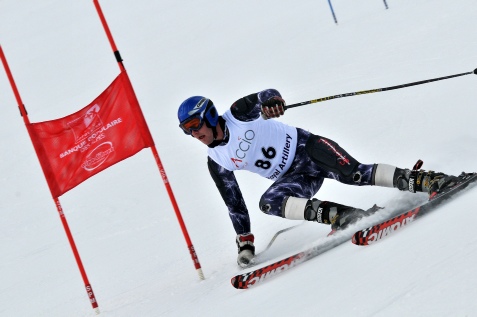
The Problem with Boots
Expert skiers can react instinctively and athletically. They move as required and never freeze or even pause for more than a moment in a fixed position. They control their skis without thought. They are in natural alignment and dynamic balance, free to concentrate fully on their line and the terrain ahead.
Boots over-
The boots lean outwards too much for the skier’s legs.
The skier is forced to adopt a knees-
This is a less common problem. But it should still be corrected.
Correct canting:
The outward lean of the boots is correct for this skier.
The centres of the skier’s knees are vertically above the centres of the flat skis.
This is natural alignment.
To achieve this you must either be very lucky or take the trouble to make sure your ski boot alignment is adjusted to conform with your lower legs.
Boots under-
The boot cuffs do not lean out enough for this skier’s legs.
Therefore the skier has to adapt by holding the knees inside the skis to keep them flat.
This is a weak position that limits athleticism on skis. It is the most common misalignment. It is often much more apparent than is shown here.
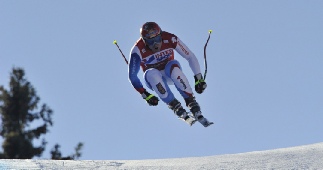
Go for it!
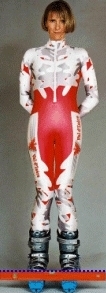

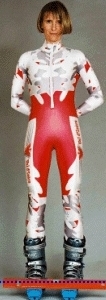
The above stance errors will not be apparent when the skier is simply standing in their boots.
They will become obvious only when the soles of the boots have to be held flat on the ground, as when skiing in a straight line.
Going up a Poma draglift is an easily observable example.
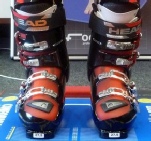
Just look at the way the cuffs of these boots lean outwards. And the left and right boots are at slightly different angles of cant. How can these crazy looking boots be any good?
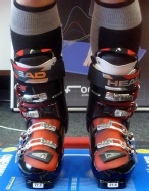
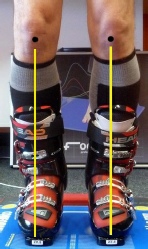
And look at those legs. They are leaning outwards too. Surely this skier must have bow-
But now step back and look at the big picture! These boots must have been adjusted with care and skill. They have been canted to match this skier’s legs. He is in a perfect stance with his knees vertically above the centres of his boots and therefore the skis. The legs are perfectly normal and the boots fit them perfectly.
This is Knee Perpendicular above Ski. Perfect KPS alignment. The target for every skier
By Peter White